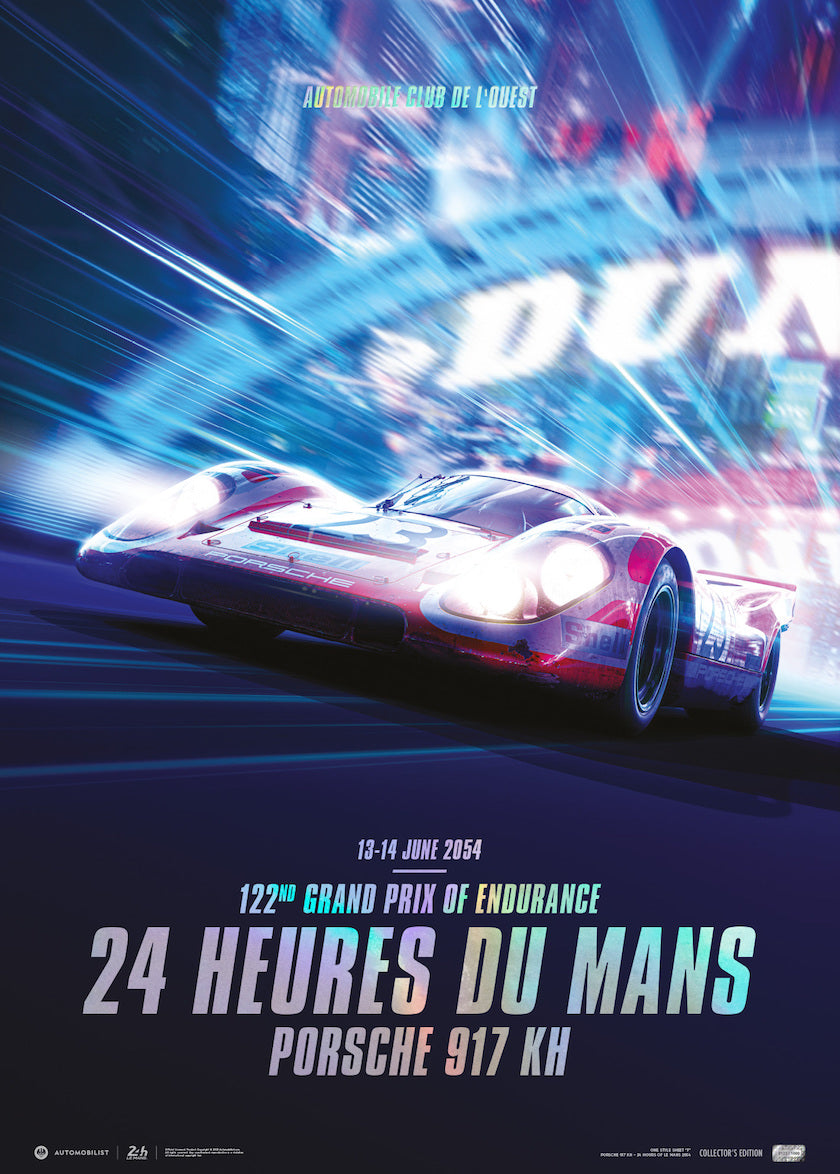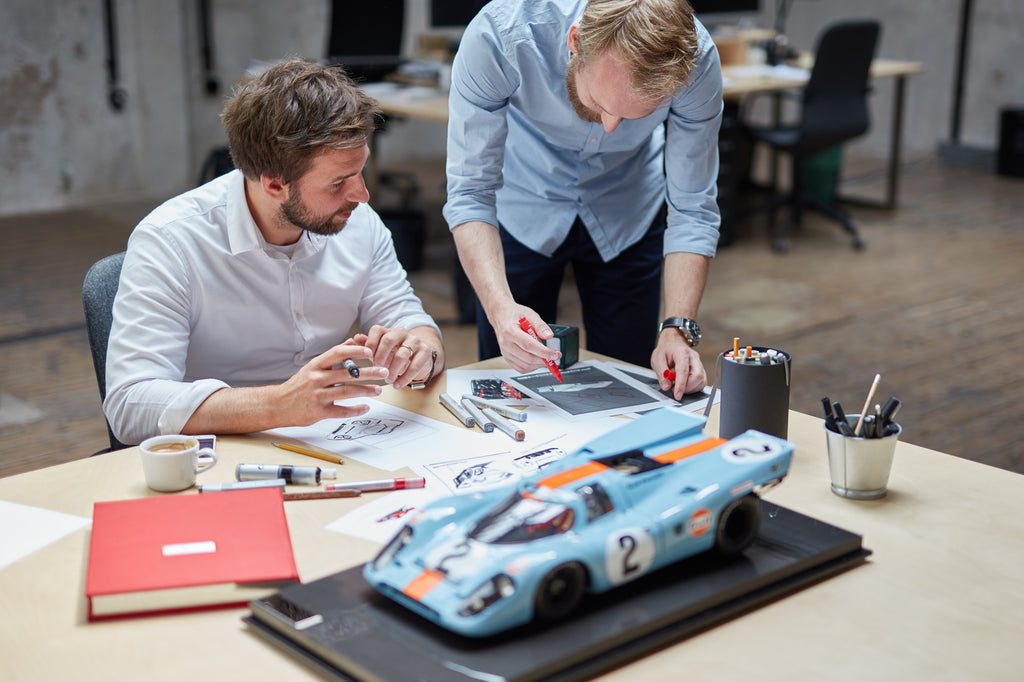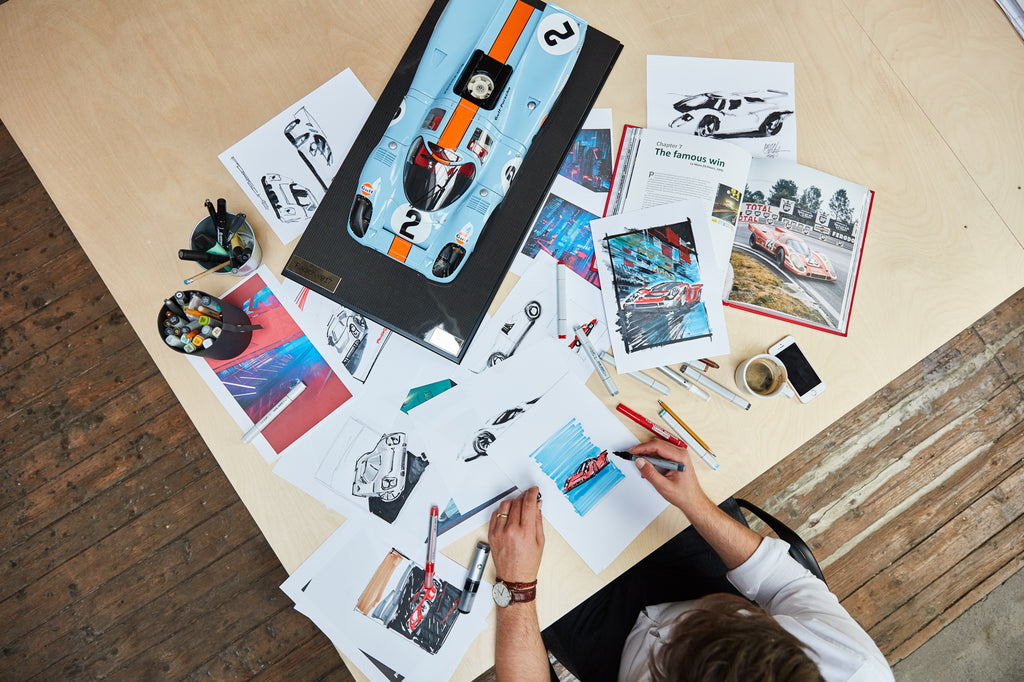
24 Hours of Le Moon
A vision of the stratospheric racing of tomorrow
After 24 hours of driving 4,607.811 kilometers, 343 laps, and through the gears of emotion, a 580 hp 917 KH sports car raced past the finish line and into the history books. On 14 June 1970, Porsche entered the elite club of Le Mans winners. To mark the occasion, a design studio commemorated the victory by looking to the future while celebrating the past.
Inspired by the golden jubilee of Hans Herrmann and Richard Attwood's Porsche victory at Le Mans, Automobilist created six posters with the theme “Past Meets Future.” Three depict classic motorsport scenes from the ultimate endurance contest: the Porsche 356 SL at the Carrera Panamericana in Mexico in 1953, the Porsche 911 Carrera RSR at the 24 Hours of Daytona in 1973 and the 917 KH at Le Mans in 1970—as an exception, with more than just a graphic background but with very real cactuses (356 SL), a pit lane situation (911 RSR) and pit buildings at Le Mans that are blurred due to “photographic technique.”

The legendary Porsche 917 races the 2054 edition '24 Heures du Mans,' marking the race's 122nd edition. (Photo: Automobilist)
The idea for the posters, a nod to the 1950s and 1960s style that the manufacturers often printed after important victories, came gradually. They represent a high-quality use of 3D cars, most of which were already created for the fine art prints. On display are rally moments, Formula 1 racing cars, pre-war vehicles, helmets, and heroes, as well as such exotic items as the Sno-Cat from the Trans-Antarctic expedition.
Usually animating historical motorsport moments in CGI, Automobilist found themselves in a new lane for this project. It was an opportunity to look to the stars and envision the society of tomorrow, how cultural norms sit in a futuristic domain, and what place racing has in a prospective world. Will mobility exist on Mars or the Moon? To create something like this, you need imagination, patience, attention to detail, and a good grasp of computer design. And, despite all that, a good sense of reality.

A Porsche 356 races a futuristic Marisan race set in 2096. (Photo: Automobilist)
Formula 1 aficionado Pavel Turek, founder of Automobilist, told us, "I think in the future motorsport will be a mixture of virtual and real action, even more than today. You’re sitting in the 21st car, there’s going to be tens of thousands of them and the fans can compete against the real drivers from their living room. And then you can win prize money of 1 million dollars and everyone will pay one dollar to participate.” He strongly believes the boundary between driving and flying will be blurred in the future. "Just imagine its implications for the world of motorsports and racing," he goes on to say.
Prague-based graphic designer Jan Rambousek and his team collaborated on the project. When Rambousek starts working on motorsport moments for his fine art prints and high-quality posters, he spends up to six months for especially elaborate scenes. The Automobilist creative director uses computers to bring unique moments from motorsport history to life—and will do futuristic ones like the 911 RSR on request.
“So many things have happened in motorsport that was never captured on camera, or only in black and white," explains Turek. "Our goal (at Automobilist) is to bring these moments back to life using CGI techniques and high-end photography—as authentically as possible, in high resolution, in large formats." This studio offers a unique window into moments missed, and now scenes to be foretold, like a Brumos Racing Porsche 911 Carrera RSR in the banked turn of the Giordano Bruno crater at the 29th Moon Race in 2078.

"Motorsport writes so many unique stories rich in emotions. From zero to hero in a millisecond, from hero to villain in an equally small period of time. As I stepped out of the corporate environment related to racing to pursue something that I could create and carve out, it had to capture these moments and frame them eternally," says Pavel.
The work on the images begins with the concept. They consider first which moments to show and selecting which car will be involved. Where is the observer standing—and where exactly does the whole thing take place? Once the location is settled, they drive to the racetrack in question and take pictures of the scene. If the location has changed even slightly, or if it no longer exists, it is recreated on the computer-based on old photographs. Then a photo shoot takes place with the people depicted in the scene—on location at the place featured in the picture. Actors are hired and dressed in period costumes.
The amount of work put into making these posters is almost unbelievable. For three artworks, graphic designers were allowed to let their imagination run wild. Not only did they send the 911 RSR to the Moon, but they also let the iconic 917 KH (the winning car from 1970) participate in a “Five Days of Le Mans” in 2054—with the small town of Le Mans transformed into a city filled with skyscrapers. In this scene, the famous Dunlop Bridge still exists, albeit as a hologram.

"Our mission is to re-energize inspiring motoring stories by using modern technology to create premium artworks," says the Automobilist team.
The 356 SL is shown sparring on the racetracks of this galaxy in 2096. Specifically, at the Northeast Syrtis Circuit on Mars in an event organized by the Martian Cargo Racing Association. Science fiction was married into the vision with expertise. The Giordano Bruno crater isn’t a fictional invention, but the Moon’s presumably youngest crater with a diameter of 14 miles (22km). You can be sure that the angle of the banked turn corresponds approximately to the real edge of the crater, based on photos and information from scientists and NASA. For the Porsche 356 SL on Mars, the Syrtis Major created is a two million square kilometer plateau that was chosen by NASA in 2018 as a potential landing site for the Mars rover Perseverance.
When Porsche was first victorious at Le Mans, humankind had only stepped foot on the Moon one year prior in 1969. Looking ahead to the next 50 years, how far will humanity's reach be able to stretch? If racing or flying on another planet is achievable, will Porsche's stratospheric reputation be able to test the stand of time?
Explore the cultural icon of the Porsche 911 and a selection of gestalten mobility titles.


